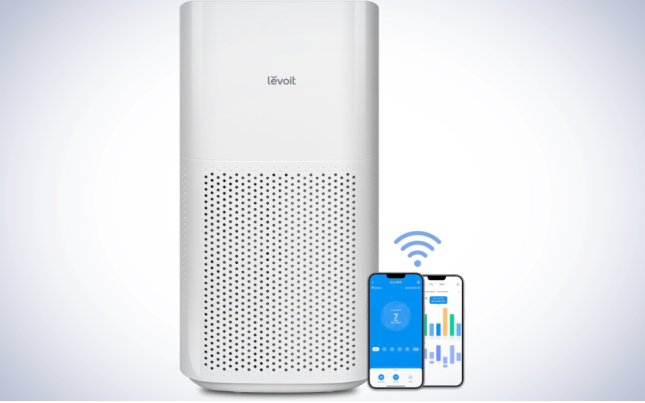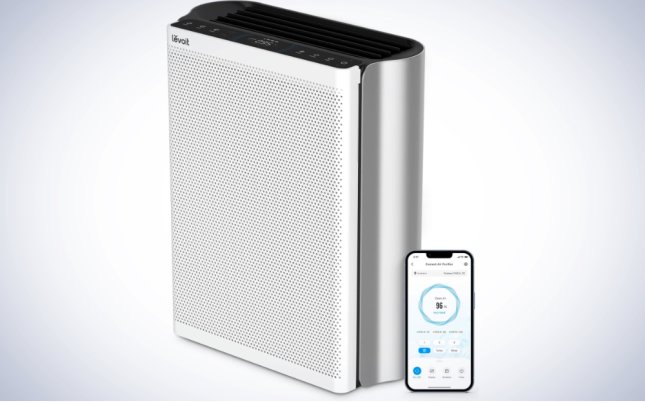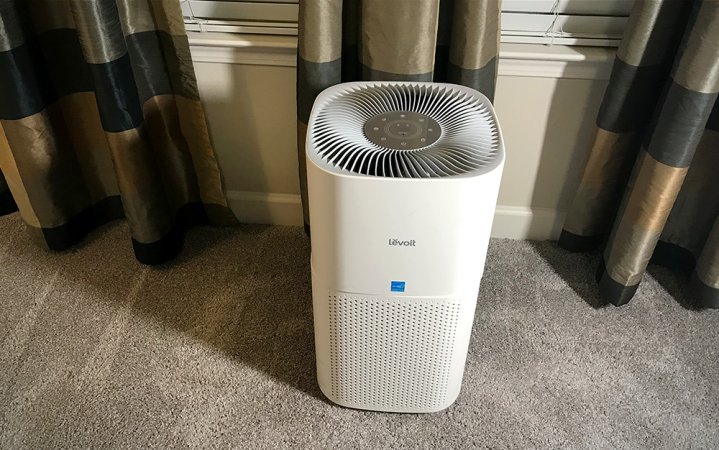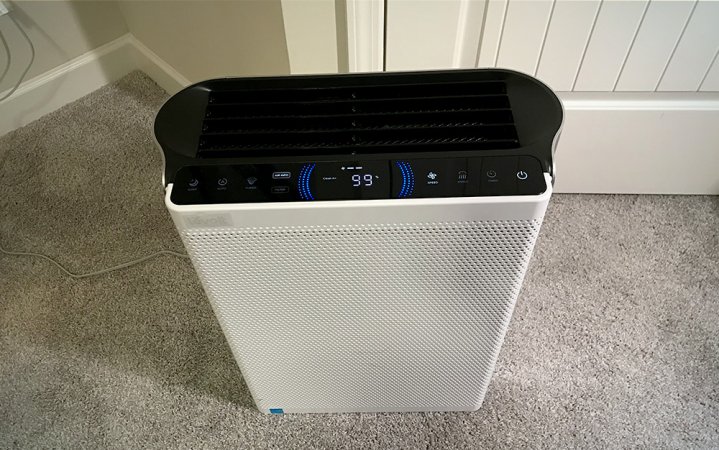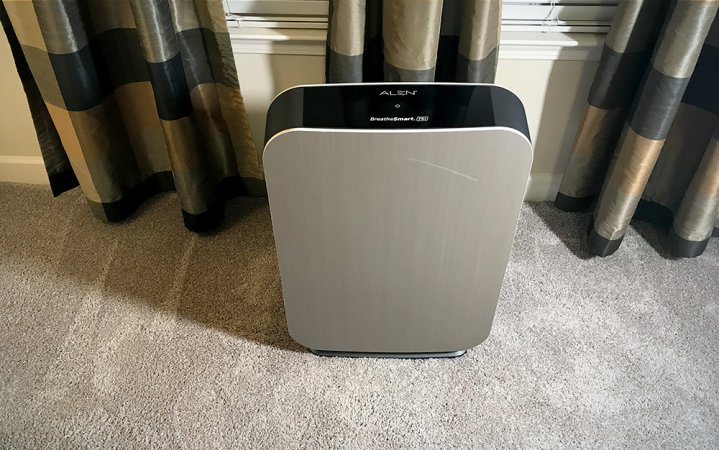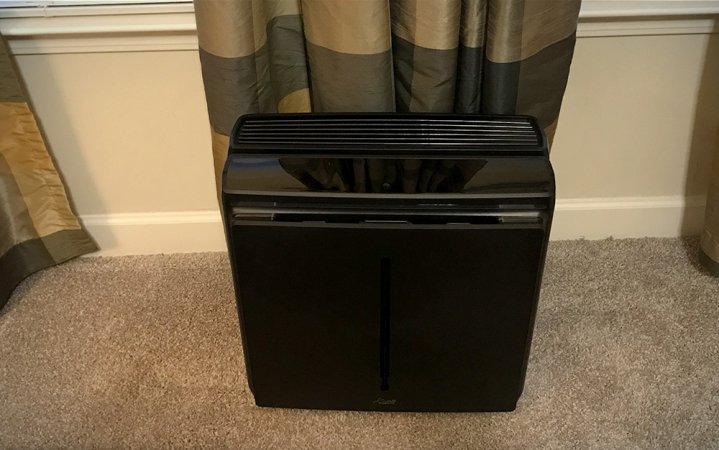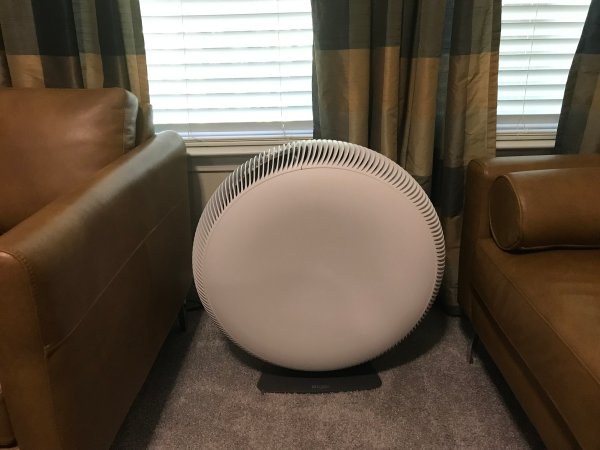We may earn revenue from the products available on this page and participate in affiliate programs. Learn more ›

Indoor air quality is negatively impacted by smoke, which is why an air purifier for smoke is so important. According to the Environmental Protection Agency (EPA), wildfire smoke can make indoor air unhealthy to breathe. And the Centers for Disease Control and Prevention (CDC) warns that cigarette smoke harms almost every organ in the body and is the leading cause of preventable death in the U.S., with secondhand smoke from burning tobacco products also dangerous and able to cause disease. And the agency warns that even the psychoactive effects of secondhand marijuana smoke can be experienced by those nearby.
And then, there’s the smoke from burnt food and other temporary household activities. “Cooking is one of the most important pollutant-generating activities at home, and it can generate a very high level of PM2.5 and volatile organic compounds [VOCs] in a very short period of time,” Dr. Jie Zhao, head of Delos Labs at Delos, tells PopSci. While he believes an externally connected range hood can help, Zhao says pollutants can still linger in the home for hours. “So, if you cook regularly, I definitely recommend having an air purifier in your kitchen/living room area,” he advises, adding that you’ll be surprised to see how dirty the filter will get if you use the air purifier for six months.
An air purifier is not a magic bullet for counteracting smoke; however, one of the best air purifiers for smoke can help to substantially neutralize the effects of smoke over a period of time. “Units that combine HEPA filters along with activated carbon filters can filter smoke particles, VOCs, and odors,” says Dr. John McKeon, CEO of Allergy Standards. And since stand-alone air purifiers are designed to work in an enclosed space, he explains that choosing an appropriately sized air purifier with enough clean air delivery rate (CADR) for the room is important. “You may want to focus on the use of air purifiers in the most-occupied rooms in your home; this will be more effective than running an air purifier with internal doors open and reducing the overall impact.” The best air purifiers for smoke can make a significant difference in the air quality of your home.
- Best overall: Levoit Core 600S Smart Air Purifier
- Runner-up: Blueair Blue Pure 211i Max Air Purifier
- Best filter change system: Oransi Mod Air Purifier
- Best for tight spaces: Levoit EverestAir Smart Air Purifier
- Best design: Alen BreathSmart 75i Purifier
- Best wall-mountable: Rabbit A3 Air Purifier
- Best splurge: IQ Air Atem X Smart Air Purifier
How we chose the best air purifiers for smoke
We conducted extensive research, reached out to experts, and did plenty of first-hand testing to compile this list of the best air purifiers for smoke. With smoking neighbors next to our primary tester (yours truly), there are always new air purifiers for homes in play to determine which are most effective at combating secondhand and thirdhand smoke (that’s the residual smoke that gets trapped in carpets, curtains, bedding, clothing, and on walls and floors). Every selection on this list has been tested. We also considered peer recommendations and consumer reviews, clean air delivery rate (CADR), and recommended room sizes.
The best air purifiers for smoke: Reviews & Recommendations
We usually have some variation of a best value/best budget and other categories on our list. However, when talking about removing harmful smoke from the air, we’re more concerned with identifying the best air purifiers than coming up with catchy titles or where to cut corners. A budget air purifier can save you money, and some may do well when you’re trying to remove the smell of your gym shoes. Also, a small air purifier may clean your room … eventually. But when you’re trying to remove smoke—something that can negatively impact your health and the health of your family members—you need to do it quickly, so we’re laser-focused on presenting you with the very best room air purifiers to achieve that objective.
Best overall: Levoit Core 600S Smart Air Purifier
Levoit Core 600S Smart Air Purifier
Specs
- Dimensions: 12.x 3 x 12.3 x 23.6 inches
- Weight: 13.7 lbs.
- Recommended coverage area: 635 square feet
- CADR: 410
- Noise level: 26-55 dB
Pros
- Among the highest clean air delivery rate (CADR)
- Auto adjusts
- App provides control via smartphone
- Captures particles as small as 0.3 microns
- Compatible with Alexa and Google Assistant
- Lightweight
- Handle for easy transport
- 3-stage filtration system
Cons
- Rather tricky to take the top off
The Levoit Core 600S Smart Air Purifier is our best overall choice if you’re looking for an air purifier to handle smoke. It’s a lightweight appliance that is easy to use. The three-stage filtration system includes a pre-filter to capture large particles like dust, hair, pet fur, and lint. Inside of that is the H13 True HEPA filter. It can capture 99.7% of tiny particles as small as 0.3 microns. This allows the filter to trap smoke particles, as well as dust and other allergens like pollen and pet dander. Inside the HEPA filter is the activated carbon filter, which captures the odors caused by smoking. I’ve found that it does a great job of helping to remove the foul smells caused by secondhand tobacco products and those occasional times popcorn burns.
The air purifier has a clean air delivery rate (CADR) of 410 cfm (cubic feet per minute). It can change the air five times an hour in a closed room that’s 635 square feet. There’s also an auto mode, which we tended to use most of the time. When it detects contaminants in the air, the fan speed automatically increases (there are four speeds) to clean the room, depending on the air quality.
The digital display on the top includes icons for on/off, fan speed, and auto mode. Other icons put the air purifier in sleep mode (which is quieter than the low mode), turn the light display on or off—or lock it (which is handy if you have kids or pets in your home), or set the timer for anywhere from 1 to 12 hours. When the air filter needs to be changed, there’s also an indicator for that. The air purifier connects to your Wi-Fi router to use the VeSync app. We didn’t use the app since it’s easier to just tap the icons on the display. However, if you download the app and create an account, you can change the settings, view air quality updates, and create schedules for when you want the air purifier to start or stop.
The digital display also serves another purpose. The color-coded air quality indicator rings are blue when the air quality is very good, green when it’s good, orange when the air is moderate, or red when it’s bad. Inside the rings is the PM2.5 display, which reveals when the air purifier detects particulate matter 2.5 microns or less. If the number reaches 115, the air has reached an unhealthy level.
The only downside to the Levoit Core 600S, and it’s not a big deal, is that unlike some air purifiers, which have an easy filter release system that’s merely pulling a panel forward, with this one, we had to twist the top half off—and usually this entails sitting in a chair to grasp the bottom half between legs to create enough resistance. Fortunately, the filter only needs to be changed every 6 to 12 months, depending on usage (although the pre-filter needs to be vacuumed every 2 to 4 weeks). Otherwise, it’s a pretty perfect air purifier.
Runner-up: Blueair Blue Pure 211i Max Air Purifier
Blueair Blue Pure 211i Max Air Purifier
Specs
- Dimensions: 22.7 x 14.4 x 14.4 inches
- Weight: 16.2 lbs
- Recommended coverage area: 635 square feet
- CADR: 410
- Noise level: 23 -53 dB
Pros
- Among the highest CADR
- Wi-Fi connectivity
- LED touch screen
- Voice control
- Stylish color choices for fabric pre-filter
Cons
- No handles
- Can get loud on highest setting
Actually, it was a toss-up between this and the Levoit Core 600S Smart Air Purifier for the best overall choice. The latter won because it’s less expensive, not as bulky, and has a handle. Otherwise, the Blueair Blue Pure 211i Max has many of the same features. It also has a feature that the Levoit Core 600S doesn’t have: swappable cloth filters. The appliance comes with a Stockholm Fog (grey) washable pre-filter, which is great if you dislike most air purifiers’ sterile-white color. However, you can also purchase an additional pre-filter at a nominal cost ($12.99) in three other colors: Limestone, Sand, and Moss.
The air purifier can clean 635 sq. ft. in just 12.5 minutes and 1,524 sq. ft. in 30 minutes. It has four fan speeds, in addition to a night mode that also dims the lights. The auto mode adjusts the fan speed depending on indoor air quality, and it’s our default mode. The digital panel includes icons for turning the air purifier on and off, fan speed, child lock, auto mode, and night mode. There are also indicators for the filter replacement light and to show if the Wi-Fi is connected. The PM values (PM 10, PM 2.5, and PM 1) are also shown on the display, and these numbers identify the size of pollution invading my space.
We prefer the large color-coded rings (visible across the room and from any direction) found on some air purifiers to the tiny light (around 1 inch) on the Blueair Pure Pure 211i Max. But the light turns blue for excellent, green for good, yellow for moderate, orange for polluted, and red for very polluted air. The filtration system consists of the fabric pre-filter to catch large particles, the main HEPA filter for pollen, pet dander, and other allergens, and also the activated carbon layer for smoking, cooking, and other odors.
Connecting to the app lets you remotely view the current air status and control the air purifier. Filters last from 6 to 9 months, depending on usage. Although the noise level is rated between 23 and 53dB, when it’s on the highest setting, this is one of the loudest air purifiers we’ve tested.
Best filter change system: Oransi Mod Air Purifier
Oransi Mod Air Purifier
Specs
- Dimensions: 14 x 25 x 14 inches
- Weight: 23 lbs.
- Recommended coverage area: 524 to 1,268 square feet
- CADR: 363
- Noise level: 28 – 54dB
Pros
- Touchless filter removal
- Long-lasting filter
- Interesting design
Cons
- Big and heavy
Right off the bat, we were impressed with the design of the Oransi Mod Air Purifier. It’s one of those items that people walk into the house and ask, “What’s that?” because, at first glance, it doesn’t look like an air purifier. And, although orange isn’t a favorite color, the orange handle against the gray appliance looks rather stylish. Another great feature is easy-to-change filters.
Wait—did we say easy to change? Actually, it’s rather tedious to turn the 23-pound air purifier upside down and then turn the base on the bottom to the open position. It’s like trying to open a safe with a submarine-style door. However, the process is quite simple after taking the metal base off. Merely grab the air purifier by the handle to remove it and toss the entire contraption into the garbage, so hands don’t have to get dirty. Then, merely insert the new air purifier, turn the base until it locks, and flip the air purifier upright again. And you only need to do this once a year since the HEPA pleated filter and activated charcoal filter combo lasts for a year. Okay, ours lasted about 9 or 10 months before I needed to replace it, but we’re not complaining because air purifier filters work hard.
Compared to other types of air purifiers with washable pre-filters and/or filters that need to be vacuumed every few weeks, this is a much more hygienic and convenient process. Now, we’ll still take a Swiffer floor cloth and wipe the gray fabric on the outside of the air purifier every few weeks, but that’s a lot easier than disassembling the appliance.
In a 524 sq. ft room, the Oransi Mod can change the air five times in an hour, and it can clean a 1,268 sq. ft. room two times in an hour. This cool glass interface is on top, so you can just slide a finger around the fan dial to increase or decrease the fan’s output. There are 12 fan speeds (picture a speedometer), and it’s almost fun to make adjustments. The glass display also includes the on/off icon, and the filter replacement icon—which has a progress arc to let you know how much time is left on the filter (for example, when it’s at the halfway mark, we know we’ve used up 50 percent of the filter). We greatly prefer this to a replacement filter light just popping on unexpectedly.
Best for tight spaces: Levoit EverestAir Smart Air Purifier
Levoit EverestAir Smart Air Purifier
Specs
- Dimensions: 18.9 x 8.5 x 23.2 inches
- Weight: 20 lbs
- Recommended coverage area: 558 – 2,790 square feet
- CADR: 360
- Noise level: 24 – 56dB
Pros
- Smartphone control
- Voice control
- Laser dust sensor
- Long-lasting filter
Cons
- None that I could find
The Levoit Everest Air is a versatile air purifier with a slim design that allows it to fit in tight spaces or flush against the wall. Admittedly, you’ll get the best performance when an air purifier is at least a few feet away from anything else. However, you might not always have that option. Also, the slim shape makes it easier to move it completely out of the way when not in use—although its stylish, modern design isn’t something you’d likely want to hide. And although it’s not heavy, we appreciate the wheels, which make transporting it even easier.
Another unique feature is the ability to adjust the vent angles. You can select 45, 60, 75, and 90 degrees for the angle choice using the digital display on the top of the air purifier. In a 160 sq. ft. room, the Levoit Everest Air can remove smoke in 4 minutes. In a 275 sq. ft. room, it takes roughly 6 minutes. A 380 sq. ft. room takes about 8 minutes, and a 558 sq. ft. room can be cleared in 12 minutes. The air purifier has a three-channel laser duster on the side (so be sure not to block it), which scans for airborne particles and adjusts the fan speed when in auto mode.
Air quality readings on the display (PM 1.0, PM2.5, PM10) and color-coded indicator colors—blue for very good, green for good, orange for moderate, and red for bad—take the guesswork out of controlling the appliance. The fan speeds, timer, and sleep features, as well as air info selections, are on the panel as well. However, there’s an option to control the air purifier through the VeSync app on your phone or use voice control (Alexa or Google Assistant). The filter system consists of a pre-filter and a main filter to trap smoke, dust, and pollen, combined with an activated carbon filter to neutralize smoke and other odors. The pre-filter is washable and should be cleaned every 2 to 4 weeks, while the filter combo pack can last approximately 12 to 15 months, depending on use.
Best design: Alen BreathSmart 75i Purifier
Alen BreathSmart 75i Purifier
Specs
- Dimensions: 27 x 18.5 x 11.5 inches
- Weight: 27 lbs
- Recommended coverage area: 1300 square feet
- CADR: 350
- Noise level: 25 – 49dBa
Pros
- Cleans large rooms quickly
- Relatively quiet at high speeds
- Swappable panels
- Variety of filter types
- Good, halfway, and replace filter indicator
Cons
- Heavy
- Expensive
We admit that we’re partial to the Alen BreathSmart 75i Air Purifier because it was the first high-quality air purifier we tested (way back in Fall 2020), and it continues to impress with its performance. The air purifier shipped with a graphite front panel, and later, a separately purchased ( and now discontinued) red panel was added. Other designer panel choices are white, espresso, maple, rosewood, and weathered gray. The ability to swap out panels (for $59) allows the air purifier to blend in with any home design/décor aesthetic.
Over the years, we’ve also tried the various Alen H13 HEPA filters. The Fresh filter works best for both wildfire smoke and secondhand smoke. However, the company also makes a Pure filter for dust and allergens, and an Odor filter with an odor neutralizer.
The air purifier is rather heavy, but it does have a handle on the back and we’ve moved the BreathSmart 75i all around the home. It’s been in the bedroom, open-concept living area, and guest bedroom. And the air purifier performs well in every space to quickly and quietly remove smoke while looking good in the process.
There’s a pre-filter that needs to be vacuumed every few weeks. Otherwise, the actual filter can last from 12 to 15 months, depending on usage. The filtration system is easy to access—just grab the magnetic panel on either side and gently pull forward to access the filter box. No laying the air purifier on its side or turning it outside down.
The digital panel on the top includes the power button, five speed selections, as well as the auto function, Wi-Fi indicator, child lock, and light setting. The color-coded ring lets me know at a glance if the air is excellent, good, average, bad, or poor. There’s also an optional ionizer feature that never gets turned on. The filter indicator has three stages (good, halfway, replace), which help you gauge the filter’s life. The controls—which consist primarily of words instead of icons—are simple and easy to read. Usually, we don’t let guests tinker with the air purifiers, but we trust them to operate this one since it’s quite user-friendly.
Best wall mountable: Rabbit A3 Air Purifier
Rabbit A3 Air Purifier
Specs
- Dimensions: 19.7 x 18.9 x 8.4 inches
- Weight: 20.3 lbs
- Recommended coverage area: 1,070 square feet
- CADR: 257
- Noise level: 20.3 – 51.0 dB
Pros
- Wall-mountable and self-standing
- Connects wirelessly
- 6-filter system
- Customized filters
- Plethora of design panel choices
- 4-stage replace filter notification
Cons
- Expensive
The Rabbit A3 Air Purifier ships with a wall-mounting kit (which includes a bracket and hanger screws) for installing it on the wall—which can be a lifesaver in a space-challenged area. And it can be mounted either right side up or there’s the option to mount it upside down. However, we only use it in the freestanding floor position. It’s not a small air purifier, but it’s lightweight, and the handle makes it easy to transport. The Rabbit A3 can change the air four times an hour in a 535 sq. ft. area and two times an hour in a 1,070 sq. ft. area. The sensors on the Rabbit A3 detect pollutants and automatically adjust fan speed as necessary.
The air purifier has a 6-stage filtration process that includes a washable pre-filter that should be cleaned every 3 months. The medium filter traps smoke, pollen, and pet dander, while the activated carbon filter traps and removes odors, and the BioGS HEPA filter traps particles 0.3 microns in size. Rabbit also makes a customized filter, available in four options: germ defense, pet allergy, toxin absorber, and odor remover. The medium, activated charcoal, BioGS HEPA and customized filters are included in the filter kit, and are replaced at 12-month intervals, depending on use. Replacing the kit is easy, since the front panel snaps off.
The display panel includes informative icons that make operating the air purifier quite easy. The Filter replacement icon has four vertical LED lights to indicate whether the lifespan is new to 10 months, 9 to 7 months, 6 to 4 months, or replace within 3 months. Above other icons, the vertical LED lights are used to indicate Wi-Fi and Bluetooth connection status, air quality, fan speed, auto mode sensitivity, and light control. There’s also a setting for the negative ion generator, but we never use that setting. After downloading the app, the air purifier can also be controlled via smartphone or app.
The Rabbit Air 3 has one more notable feature. We tested the standard black model, and it also comes in a standard white model. However, you can also select a cool insert instead from the Artists Series for only $20 more—or buy an additional panel for $70. Selections include cherry blossom-white, irises, cherry blossom-black, great wave, starry night, vase of flowers, and Lofoten Islands.
Best splurge: IQ Air Atem X Smart Air Purifier
Specs
- Dimensions: 10 x 27.1 x 27.1 inches
- Weight: 28.7 lbs.
- Recommended coverage area: 1,650 square feet
- CADR: 422
- Noise level: 26-55 dB
Pros
- Among the highest clean air delivery rate (CADR)
- Among the quietest air purifiers
- 8 fan speeds
- Great for large rooms
- Can stow power cord in cord channel
- Auto adjusts
- App provides control via smartphone
- Captures particles as small as 0.003 microns
- Can be placed directly against a wall
- Faux leather handle and mobile base
- HyperHEPA Plus filter
Cons
- Super expensive
- Filters don’t contain carbon
If money is no object and you need to remove smoke from a large space, consider the powerful IQ Air Atem X Smart Air Purifier. It has a sleek design that belies the appliance’s functionality. While the air purifier looks like a stylish speaker, it’s actually one of the most powerful air purifiers on our list. However, the high price ($1,399) kept the air purifier out of the top spot or the runner-up spot since it may not be cost-effective for the average consumer.
I’ve only had it for a few months, but the German-made air purifier is quickly becoming one of my favorites. It has a slim design that doesn’t take up a lot of floor space—and it also looks good in my space. The Atem X can also be placed flush against the wall or other type of vertical surface, which is unusual for air purifiers. That’s because the air outlet grille and the three air inlet grilles are within the circumference of the air purifier, and it’s easy to adjust the airflow.
With a CADR of 422, the Atem X quickly removes smoke from the air. In a 1,600-square-foot room, it can clean the air twice in an hour. In a much smaller room, it conditions the air much faster. However, the air purifier is surprisingly quiet. As expected, it can get loud on the highest settings, but I’ve found that it’s quite effective on the lower (and quieter) settings.
Another feature I like is the eight fan speeds, compared to the three to four speeds on most air purifiers. All controls are on the back of the device, which hides them from view and provides a cleaner look. However, if you really want to put it flush against a wall, remember that it might be awkward trying to access the controls on the back.
The touch controls include the power button, smart mode, fan speed slider and air quality indicator, light, Wi-Fi, and filter status. (Some models also have an Ethernet port.) The air quality indicators are green for good, yellow for moderate, orange for unhealthy for sensitive groups, red for unhealthy, purple for very unhealthy, and purple flashing for hazardous.
Using Wi-Fi, the Atem X can be controlled via app, and I can also schedule a time for the air purifier to turn on. The three air purifier filters are contained in impactors, which collect large particles, fibers, and dirt. The filters are designed to last for a year or two, and when replacing them, it’s recommended to clean the impactors as well. However, in dusty environments or homes with pets, the filters may need to be replaced sooner, and the impactors may need to be cleaned more often. The filters do not contain carbon, and I was initially skeptical that they would effectively remove secondhand smoke. However, the HyperHEPA Plus filters do an excellent job of cleaning the air.
The Atem X weighs 28.7 pounds and has a faux leather strap on the back to make it easier to carry. It’s heavy enough that I don’t move it around unless I’m vacuuming. However, it also comes with a mobile base that can be mounted on, making it much easier to move. Since the mobile base is specifically designed for use on hard surfaces (and not recommended for carpeted surfaces), I didn’t attach it.
What to consider when shopping for the best air purifiers for smoke
“Air purifiers are effective in filtering out particulate matter from smoke,” Dr. Zhao of Delos Labs says. “For example, one study that looked at the efficacy of portable air purifiers in controlling wildfire-generated fine particulate matter (PM2.5) concentrations found a 73 to 92 percent reduction in indoor PM2.5 levels within eight hours.” These are some factors to remember to ensure your air purifier works to remove smoke effectively and efficiently.
HEPA filter
The presence of a HEPA filter is one important consideration. “Smoke particles can be extremely small, which can make them difficult to trap,” explains Jack White, senior director of technical services at Rainbow Restoration. “But a HEPA filter is designed to trap tiny particles and prevent them from circulating back into the air.”
Zhao agrees and recommends looking for air purifiers with a HEPA filter–or performance that can achieve HEPA-level filtration efficiency. “A HEPA filter is rated to remove at least 99.97% of dust, pollen, mold, bacteria, and any airborne particles with a size of 0.3 microns (µm).” Since these air purifiers efficiently filter out even the smallest particles—such as fine particulate matter—Zhao says they can be very helpful in clearing smoke from the air.
“These type of portable air purifiers are a valuable addition in homes, especially for individuals with respiratory issues such as asthma, allergies, COPD, cardiovascular conditions, or weakened immune systems, as well as older adults, pregnant women, and young children,” Zhao says.
CADR and space size
For each selection on our list, we also provide the clean air delivery rate (CADR) and recommended room size. Those are two stats you need to know when choosing an air purifier for smoke. “A high CADR is important when it comes to air purifiers because it’s an indication of the machine’s ability to quickly and effectively filter out smoke particles, along with other airborne pollutants like dust, pollen, etc.,” White says.
Zhao explains that the size and number of air purifiers a home may need depends on the size of the space itself. “It is important to get a purifier that is able to cover the area in which you plan to place it,” he says. “You can determine whether the purifier is large enough for your space by looking at the manufacturer’s recommendations and the CADR of the device.” So what’s the connection? “The higher the CADR, the more equivalent air changes per hour [ACHe] for a specific space size, and the quicker the replacement of air in your space with clean air.”
Several popular air purifiers didn’t make our list because they had low CADR numbers or didn’t provide this information.
Activated carbon filter
“Along with a HEPA filter, an activated carbon filter acts as an odor neutralizer,” White says. “Smoke contains various chemical compounds that contribute to its distinctive smell and toxicity, but the activated carbon is like a sponge – it’ll absorb all of those unpleasant smoke odors and pollutants.”
Other factors to consider
Is it helping or hurting your efforts?
Zhao says most air purifiers have one or more filters inside, which must be replaced every 6–12 months. “Dust, pet dander, and other types of particulate matter may contain bacteria, viruses, and mold spores, which can grow inside the filter.” He says some air purifiers have UVC (Ultraviolet-C) and ionization features that can deactivate or kill these microorganisms, prolonging the filter’s life and reducing re-exposure risks when replacing the filter.
However, he warns that there might be a risk of ozone generation when using some features. “Exposure to ground-level ozone can contribute to health issues such as breathing problems, airway damage, increased risk of lung infection, and aggravation of lung diseases.” If you’re considering an air purifier labeled “electronic air cleaner” or “ionizer,” he recommends looking for devices with the UL2998 certification for low/no ozone emission.
Dr. John McKeon of Allergy Standards added this. “When shopping for an air purifier specifically for smoke filtration, look for models that have been independently tested and certified by reputable third parties like the asthma & allergy friendly® Certification Program.” He points to the Rabbit Air A3 as being certified asthma & allergy friendly.
Noise
Some air purifiers are slightly quieter or noisier than others. However, Zhao warns that noise is inevitable for air purifiers. “A majority of them have fans inside, so depending on the fan speed and product design, you may hear some background noise (which sounds much like “white noise”) when they are on.” If you run the air purifier regularly, you may use a lower setting, but when you’re actively trying to remove smoke as quickly as possible, you’ll need to boost the fan speed—which in turn will increase the noise level.
Ease of use
Tim David, owner of Airlucent, recommends additional features like multiple fan speeds to adjust the performance. “Newer purifiers also have smart features like air quality sensors, which should be a must if you are mainly filtering smoke,” he says. ‘This way, you will know for how long you need to run the purifier. “
FAQs
Yes. If they have the right CADR and are appropriately sized for the intended room, they can help reduce smoke. Keep in mind, for example, if someone is smoking while the air purifier is running, it’s going to take longer to clean the room since it’s battling both the active and the old smoke at the same time.
While manufacturers provide recommendations, how long the air purifier lasts will depend on how often you use it. For example, the manufacturer may provide a 12-month lifespan—if you use it 8 hours a day. But if you’re running it 24/7, the filter is going to wear out much faster.
Yes. For maximum performance, don’t place the air purifier in a corner, against a wall, or up against anything else.
Not likely. Even if your home is the size of a shoebox, you probably have a bathroom and some other room with a door. Air purifiers don’t go over or under doors. On the other hand, if you put an air purifier in a closed room, it will work much more efficiently, assuming it’s the right size.
As a general guideline, you should know the size of your room/area, and then get an air purifier designed to clean a larger room. Manufacturers are sometimes guilty of overestimating performance.
Final thoughts on the best air purifiers for smoke
- Best overall: Levoit Core 600S Smart Air Purifier
- Runner-up: Blueair Blue Pure 211i Max Air Purifier
- Best filter change system: Oransi Mod Air Purifier
- Best for tight spaces: Levoit EverestAir Smart Air Purifier
- Best design: Alen BreathSmart 75i Purifier
- Best wall-mountable: Rabbit A3 Air Purifier
- Best splurge: IQ Air Atem X Smart Air Purifier
Smoke—in any form—can be hazardous to your health. Fortunately, there are air purifiers designed to remove smoke effectively and efficiently. If you choose one with a good CADR number and air transfer rate, combined with a HEPA filter and active carbon filter, you’re on the way to keeping your home clean, fresh, and safe.
